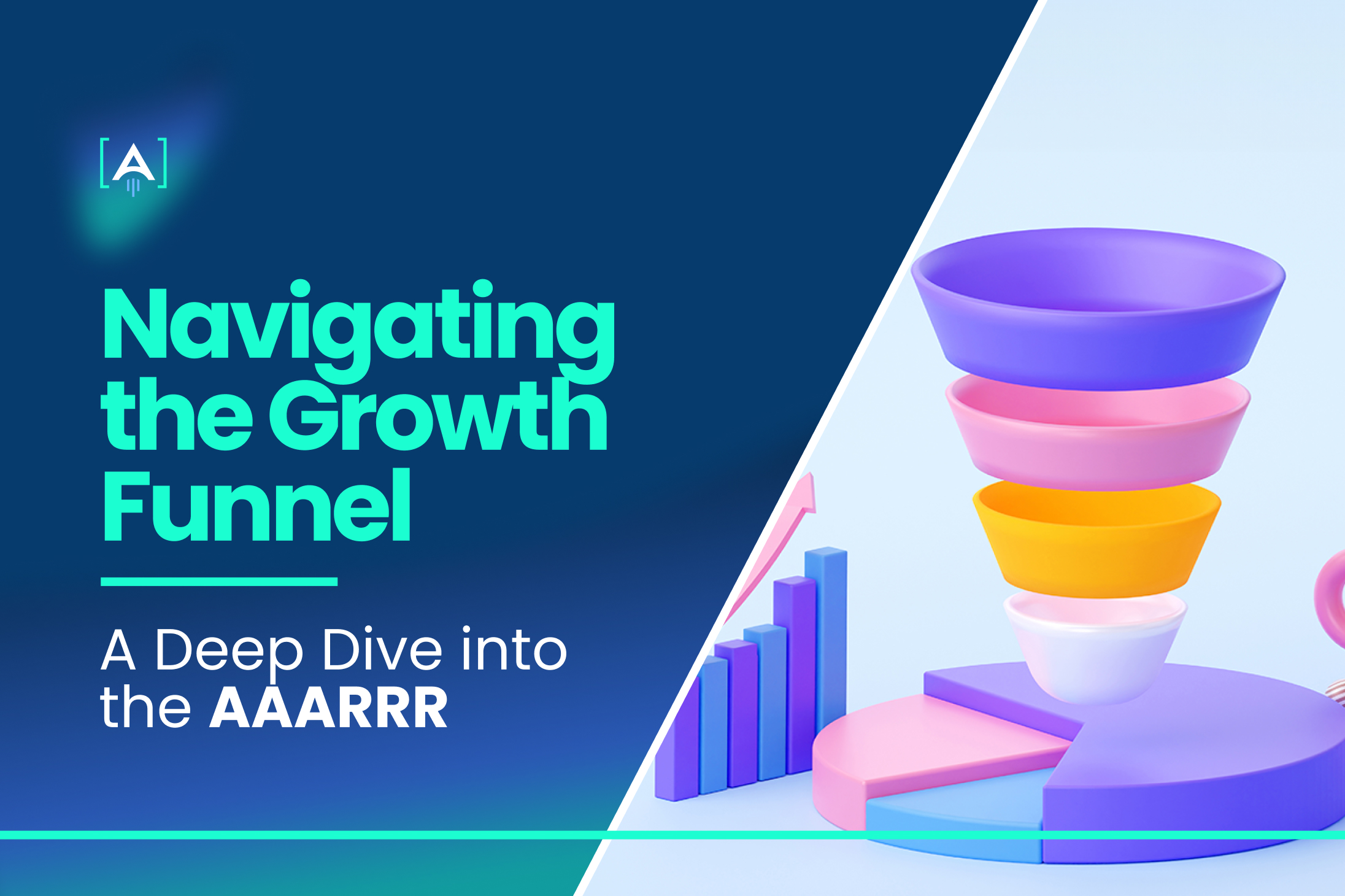Have you ever felt lost in the vast marketing strategies, drowning in data and vanity metrics?
Vanity metrics are usually those numbers that are simple to measure and provide plenty of data, but they don’t directly contribute to your business’s real gains.
It’s time to elevate your digital sails and embark on a clear path to marketing success.
Partnering with a conversion rate optimization agency can help you focus on metrics that truly matter and drive substantial growth for your business.
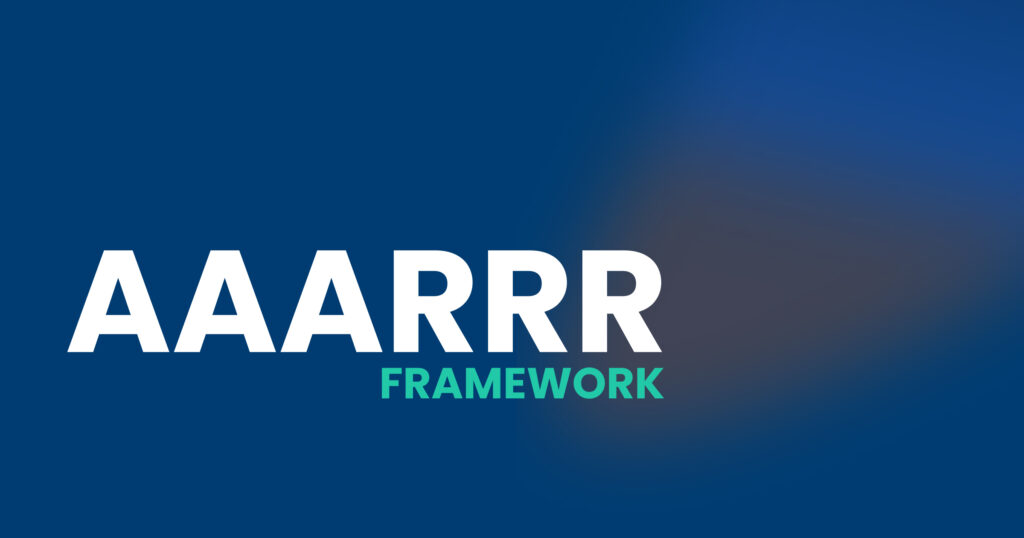
Modern Growth Marketing Strategies
Modern growth marketing demands more than just vanity metrics. We’ve all been there, counting likes, shares, and clicks like they’re gold coins in a treasure chest.
But what do they genuinely signify? Do likes and clicks translate into revenue, customer satisfaction, or long-term loyalty? Not necessarily.
What really matters in growth marketing is whether your customers are happy, whether they stick around for the long run, and whether your efforts lead to actual success, like increased sales or revenue.
So, it’s essential to dig deeper to understand what’s happening beneath those numbers. It’s about building genuine relationships with your audience, understanding their needs, and achieving meaningful results that benefit your business.
This is where the AAARRR Framework, crafted by Dave McClure, comes into play. This framework is simple, powerful, and transformational for startup founders, growth marketers, CEOs, entrepreneurs, product managers, and investors.
In this deep dive into the AAARRR framework, we’ll explore its origins, the significance of each stage, and how you can use these metrics to reach customer satisfaction and revenues.
So, if you’re ready to embark on this journey, let’s uncover the secrets of Pirate Metrics – your trusted guide to conquering the digital seas of growth marketing.
Who Invented AAARRR Framework and What Was His Vision?
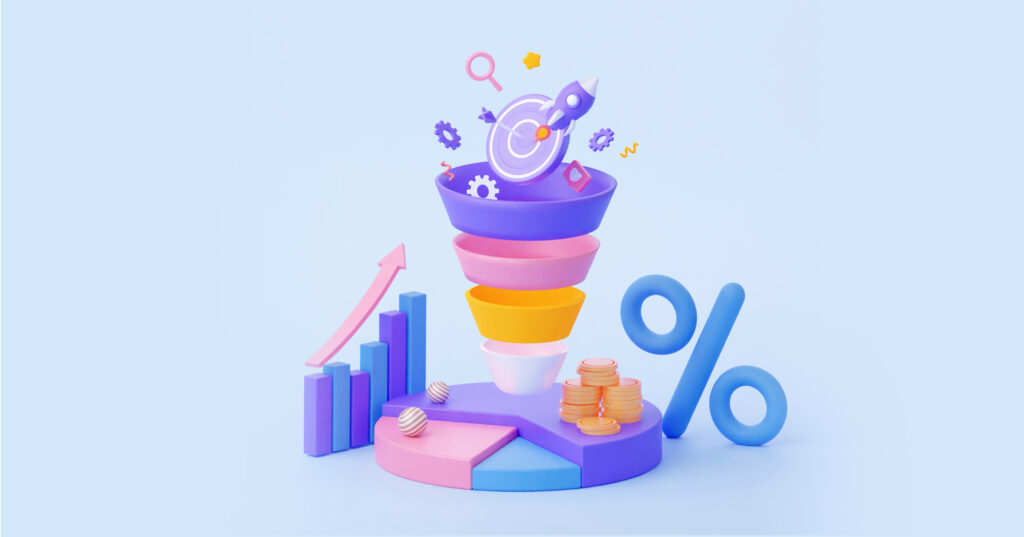
The brilliant mind behind the AAARRR Framework is Dave McClure.
An investor and entrepreneur, Dave McClure recognized the challenges startups face in the ever-changing digital landscape.
When he came up with this framework, he had two clear goals in mind, and they were more than just lofty ideas.
These goals were practical, driven by a deep understanding of what it takes to steer a startup toward success.
Goal 1: Keeping Young Companies on Track
McClure wanted to ensure that young, ambitious companies maintained their focus on the metrics that contributed to the health of their business.
Startups often face distractions and competing priorities. That’s why McClure’s goal was like a guiding star. It was a reminder that amidst the noise, you must stay focused on what matters – only those metrics that drive growth and success.
Goal 2: Using the Right Data
McClure understood that having data was one thing, but using the correct data was another. In a digital age where information is abundant, it’s easy to become overwhelmed. Dave’s vision was to help companies sift through the noise and focus on the signals.
He wanted businesses to use the correct data to measure what was working with their product and marketing efforts.
Any online business, from B2B SaaS products to e-commerce websites and direct-to-consumer offerings, can apply the AAARRR framework.
Pirate Funnel and its Connection to Pirates
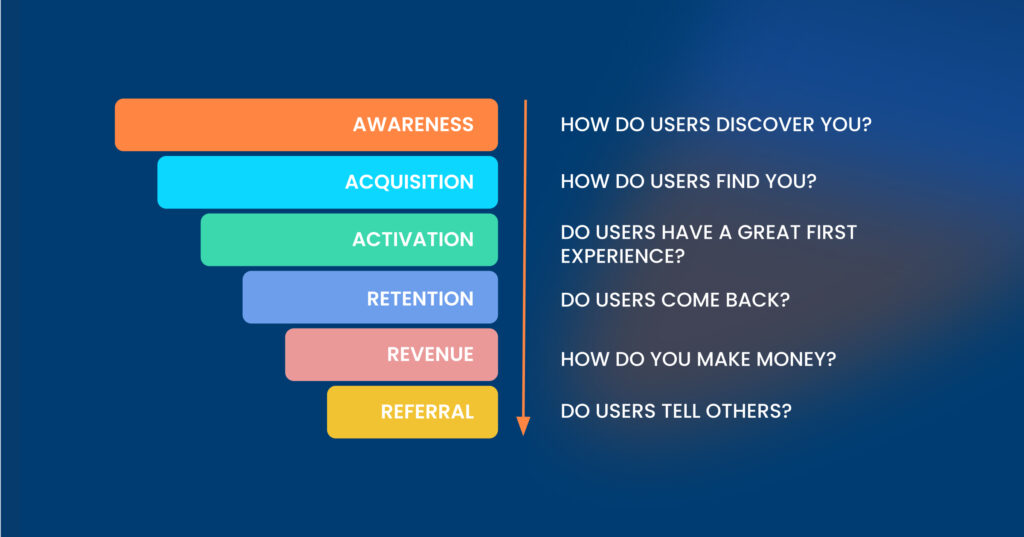
The Pirate Funnel’s humorous connection to pirates might initially seem a bit odd. But don’t get confused; it’s a serious business tool.
The Pirate Funnel got its name because it spells out “AAARRR,” just like a pirate’s exclamation. But it’s more than just a clever play on words.
The Pirate Funnel is a map that leads us through the different phases of customer interaction: Awareness, Acquisition, Activation, Retention, Revenue, and Referral.
Connecting Pirate Funnel to pirates’ adventures is a memorable way to capture the essence of these stages. Pirates were known for their journeys on the high seas, seeking treasures and facing experiences.
Similarly, the Pirate Funnel guides you through the voyage of customer interaction, where the treasure is revenue and success.
After all, as Richard Branson emphasizes in his book “The Virgin Way: Everything I Know About Leadership,” – fun is one of the most important and underrated ingredients in any successful venture. If you’re not having fun, then it’s probably time to call it quits and try something else.
Understanding the AAARRR Framework in Detail
Now, let’s dive deeper into the heart of the AAARRR Framework.
Defining Awareness
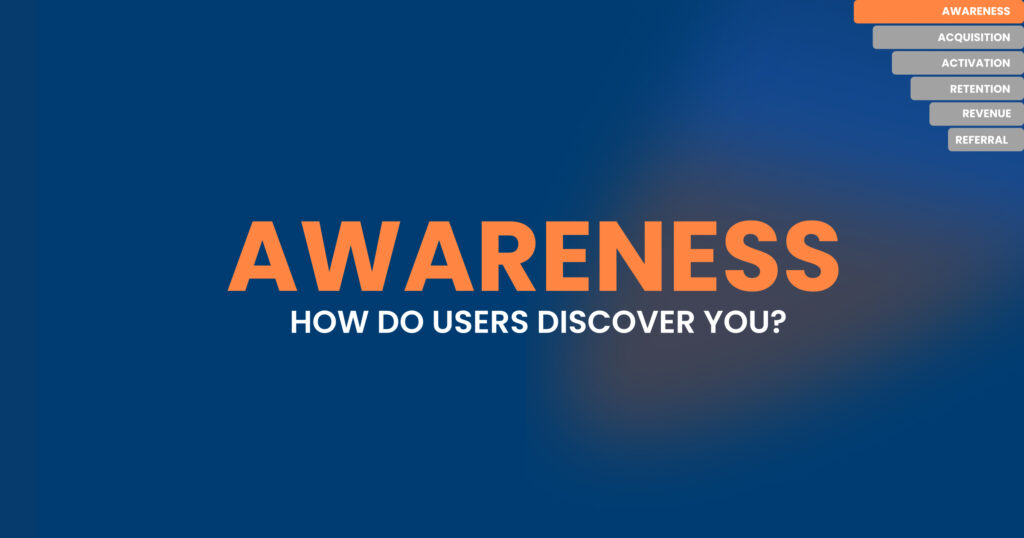
In growth marketing, Awareness is when potential customers first know your product or service. It’s the moment they discover your presence in the vast digital ocean.
You might wonder why Awareness is the first stop on this journey. Well, without it, the rest of the voyage doesn’t happen. Nearly half of surveyed U.S. consumers, 46%, are willing to pay extra for brands they trust, according to a survey by SaaS firm Salsify.
If no one knows your product or service exists, there’s no chance for Acquisition, Activation, retention, revenue, or referral.
So, how do we gauge Awareness? It starts with asking the right questions. For instance:
- How are potential customers finding out about your product or service?
- Are your marketing efforts effectively reaching your target audience?
- Do people recognize your brand and understand what it offers?
Metrics play a significant role here. You might track metrics like website visits, social media impressions, or the number of people who view your online ads.
Acquisition
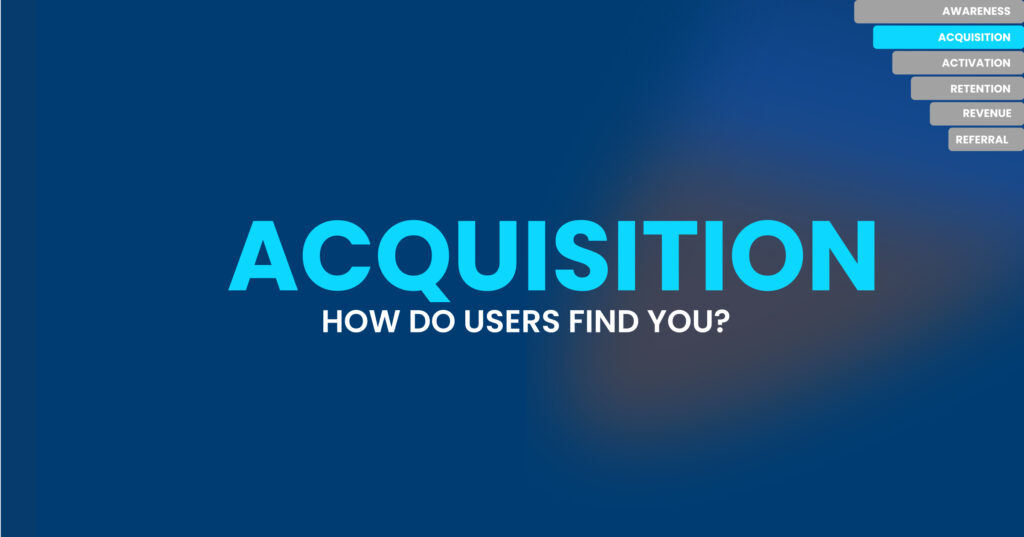
Acquisition is when you turn those aware of your product into active users or customers. It means converting potential customers into actual users.
What’s the difference between Awareness and Acquisition? Awareness is about being seen so people notice you. But Acquisition takes it further, persuading those who notice to take action.
When it comes to Acquisition, three engines can power your journey:
- Viral Growth: When your existing users or customers recommend your product to others. In other words, your satisfied customers become your advocates.
- Sticky Growth: Here, the focus is on retaining and keeping your current users engaged. It’s about ensuring they stay on board instead of going to a competitor.
- Paid Growth: This engine uses advertising and marketing to acquire new customers. You invest resources to bring people on board.
The Bullseye Framework for Channel Prioritization
In the Acquisition world, it’s not just about getting as many people on board as possible; it’s about doing it smartly. This is where the Bullseye Framework comes into play. It’s a way to prioritize your channels for acquiring customers.
Imagine it like a pirate aiming for a target. The outer ring represents all the possible channels for customer acquisition. You must test these channels and see which ones work best for you.
Once you find your “bullseye” – the most effective channel – you focus your efforts there.
Activation
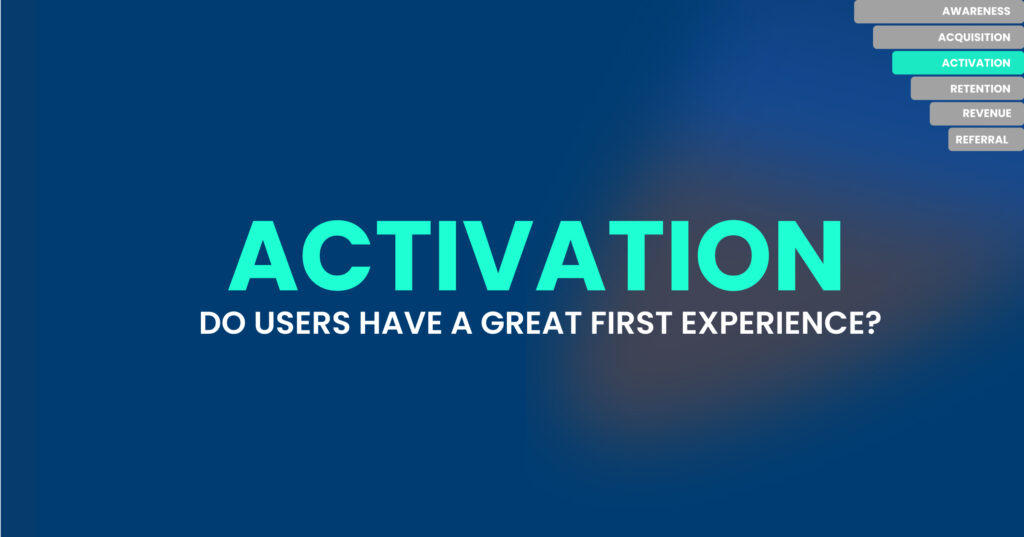
Activation is when customers experience the “Aha” or “Wow” moment. It’s when they realize the actual value of your service or product.
The Power of Early Aha Moments
This Aha moment needs to happen early in the customer journey.
Why? Well, it’s the hook that keeps customers engaged. Think of it as the moment you’re drawn into an enthralling story, and you can’t wait to see how it unfolds.
Early “Aha” moments have a profound impact on customer retention. When customers experience value quickly, they’re more likely to stay, explore more, and eventually become loyal advocates for your product or service.
Measuring Activation: Key Questions and Metrics
You need to consider some critical questions and metrics to ensure you’re on the right track with Activation:
- What’s the Aha moment for your customers? It’s vital to understand what truly resonates with your audience. What’s that moment when they say, “Wow, this is exactly what I needed”?
- How soon does it occur in the customer journey? The earlier, the better. If it’s delayed, you risk losing them.
- What metrics capture the ‘Aha’ moment? Look for data that indicates when customers truly start deriving value from your product. It could be specific actions, like completing a profile or making their first purchase.
- Are your onboarding and user experience aligned with facilitating this moment? The journey to the Aha moment should be smooth and intuitive.
Retention
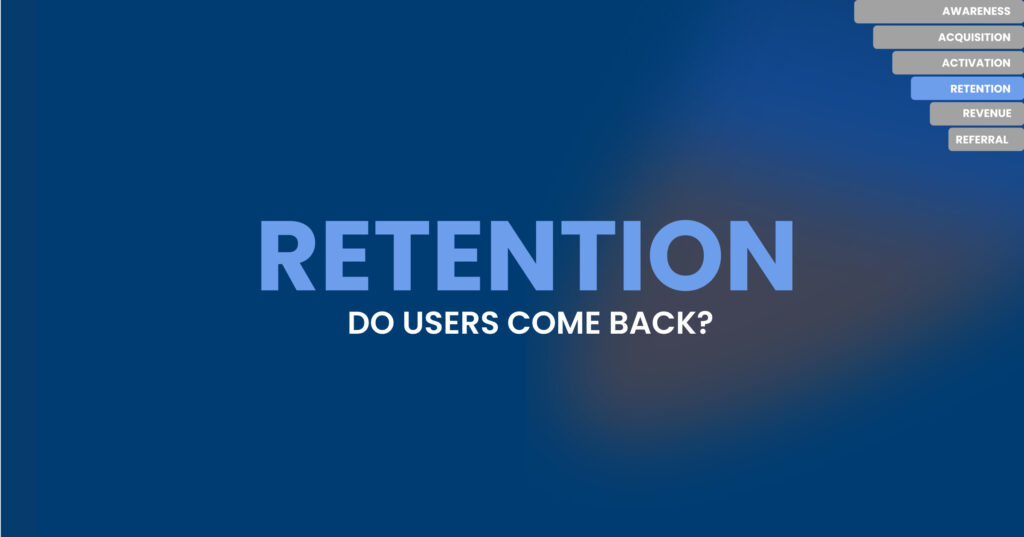
Retention is all about how many people make repeat purchases or revisit your business. Once you’ve acquired a customer, you want them to return, buy upgrades, and make repeat purchases.
The Costs of Acquiring vs. Retaining
Here’s an essential point about this stage of the Pirate Funnel. New businesses are often excited to gain new customers.
In fact, acquiring a new customer can be 25 times more expensive than keeping an existing one, according to a study by Harvard Business Review.
Imagine a customer paying $1,000 monthly and staying with your business for two years, totaling $24,000. If acquiring them costs only $1,000, that’s a fantastic business scenario.
You’d recover your acquisition cost by the end of the first month. This is known as the “payback period.”
The crucial metric is the LTV (Lifetime Value) to CAC (Customer Acquisition Cost) ratio.
In this case, you’d have a 24-to-1 LTV ratio. Very few businesses achieve this, but those that do tend to become highly successful. With substantial revenue, they can continuously reinvest profits for exponential growth.
For most businesses, achieving a ratio of three to five is already a sign of a healthy business. A percentage of seven or higher becomes even more attractive, especially for Series A investors.
They closely examine this ratio to determine how much they should invest in a business.
A healthy LTV to CAC ratio allows businesses to speed up their growth and attract significant investments without waiting for a 24-month cycle. It’s about taking the opportunity now to scale up and generate returns.
How to Improve Customer Relationships?
Building strong customer relationships retains customers and turns them into advocates for your brand.
Here are essential steps to improve customer relationships.
- Prioritize exceptional customer service to build trust and loyalty.
- Tailor interactions and offers to individual customer preferences.
- Keep customers engaged with relevant updates and offers.
- Reward repeat customers with incentives.
- Seek and act on customer feedback.
- Consistently deliver high-quality offerings.
- Track customer retention, churn, and Net Promoter Score (NPS) to gauge success.
Revenue
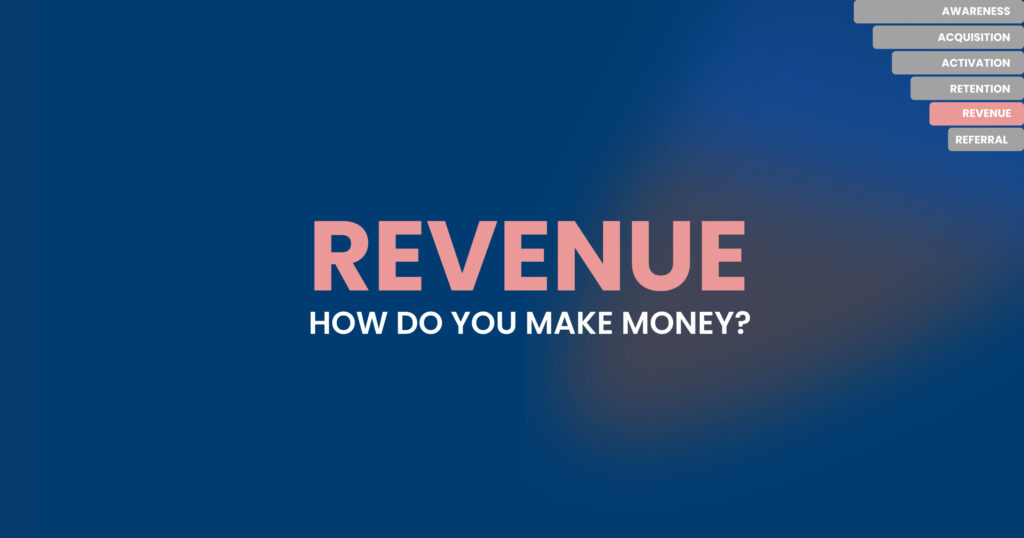
Revenue measures your business’s success. It’s about creating a lasting connection with your customers, encouraging them to return, and building a trustworthy brand.
A Wealth of Revenue Models
Regarding Revenue, there are many models and strategies to consider. Depending on your business type and goals, these models are different routes to reach your treasure trove.
For instance, you might opt for subscription-based Revenue, where customers pay regularly, or the classic pay-per-product model.
You could explore the freemium model, offering basic services for free and charging for premium features.
The Significance of Customer Lifetime Value (CLTV)
Customer Lifetime Value is like a report card for your business. It’s a reflection of how well you’re nurturing the relationship.
No company or person can solve every problem in the world, and that’s where businesses come into play. They’re here to offer solutions that consumers need, be it products, services, or experiences.
The same works with Revenue in Pirate Funnel. It’s about creating that trust and loyalty by consistently delivering exceptional quality. This trust eventually evolves into customer loyalty, where the Lifetime Value becomes significant.
Think of giant brands like Coke or Pepsi. Once you choose one, you tend to stick with it. The difference in taste is often subtle, yet loyalty remains.
The principles remain the same if we shift our focus to B2B relationships. It’s all about providing value consistently, month after month. If you address your client’s pain points and problems, they’ll continue working with you. It’s a journey of value creation.
Understanding Revenue Beyond Monetary Terms
Now, here’s the exciting part. Revenue goes beyond money. It’s about building a brand that customers believe in and continue to support. It’s about creating a cycle where they return, refer others, and keep your ship sailing.
That first interaction is the foundation of a long-lasting relationship. It’s about creating a memorable experience, a trust-building moment that keeps customers returning for more.
Referral
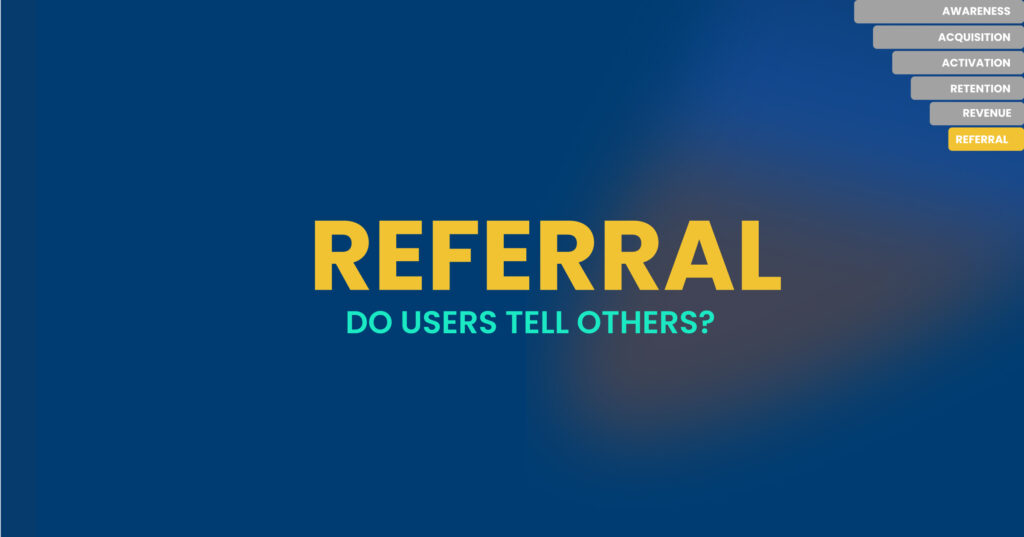
Referral answers the question: How many people recommend your business to their friends or contacts?
The Foundation of Referral Marketing
At its core, referral marketing relies on trust. People trust recommendations from friends, family, or colleagues. When someone they know suggests a product or service, it carries more weight than traditional advertising.
Trust is the secret sauce of referrals. When customers refer your business to others, they say, “I trust this, and you should too.” That trust makes potential customers more likely to give your business a try.
A solid referral program can turbocharge your customer acquisition efforts. It’s a win-win: your customers get rewarded for bringing in new customers, and your business gains fresh customers.
Let’s delve deeper into the Benefits of a Well-Executed Referral Program:
- Enhanced Customer Acquisition: Your existing happy customers become your brand ambassadors, bringing in new business without you having to invest heavily in traditional advertising.
- Cost-Efficient Growth: Instead of pouring resources into expensive marketing campaigns, you’re leveraging the trust and satisfaction of your existing customers to attract new ones.
- Trust and Credibility: A recommendation from a trusted friend or family member carries a lot of weight.
- Stronger Customer Loyalty: Referral programs attract new customers and reinforce the loyalty of your existing ones. Rewarding your customers for referring others makes them feel appreciated and more likely to stick around.
- Rapid Growth: A successful referral program can lead to exponential growth. The K-Factor, which measures how many new customers each existing customer brings in, can go beyond 1, signifying viral expansion. It’s like a ripple effect of customer acquisition.
Breaking Down the K-Factor
The K-Factor, or Viral Coefficient, is a metric that helps you measure the viral growth of your business.
Here’s the formula:
K-Factor = (Number of Invites per User) x (Conversion Rate)
In simpler terms, it measures how many new customers each of your existing customers bring in. If the K-Factor exceeds 1, each customer attracts more than one new customer.
For instance, if one customer refers your business to three friends and two of those friends become customers, your K-Factor is 2 (3 invites per user x 2/3 conversion rate).
This indicates viral growth, where your customer base multiplies organically.
Visualizing the Customer Journey

As a growth marketer, one of your key responsibilities is understanding how customers engage with your business.
This journey encompasses everything from the moment they first hear about your brand to the point where they become loyal, repeat customers. It’s like a treasure map, and every stage is a step closer to your ultimate goal: sustainable growth.
The Benefits of Visualization
Now, let’s discuss why this visualization is crucial.
- Identify Pain Points: Visualization helps pinpoint where customers encounter issues in their journey, allowing for targeted improvements.
- Optimize Customer Experience: Visualizing the journey enables you to enhance each step for a seamless experience.
- Focus Your Efforts: Allocate resources strategically by identifying which journey stages need attention most.
- Improved Communication: Visuals simplify complex strategies, ensuring your team and stakeholders are on the same page.
- Data-Driven Decision Making: Overlaying metrics onto the map empowers you to make informed, data-backed choices.
- Strategic Adaptation: Visuals facilitate quick adjustments to changing market conditions and customer behaviors.
Customer Journey Tools
Tools like Draw.io and Lucidchart are your trusted companions when visualizing the customer journey. These platforms offer user-friendly interfaces to create detailed flowcharts and diagrams.
You can map out the entire customer voyage and even embed metrics and data to get a clearer picture of what’s happening at each stage.
Implementing the AAARRR Framework in Your Business

Now that we’ve explored the Pirate Metrics let’s dive into the practical side of putting the AAARRR Framework to work in your business.
Using the Pirate Funnel Canvas for a Step-by-step Approach.
The Pirate Funnel Canvas is your practical roadmap for applying the Pirate Metrics to your business. Each step of the framework, Awareness, Acquisition, Activation, Retention, Revenue, and Referral, is a vital milestone in the customer journey.
By filling out this canvas, you’ll pinpoint areas that need improvement.
Here’s a step-by-step guide to using the Pirate Funnel Canvas effectively:
- Define Your Steps: Customize each step to match your business’s unique characteristics. For instance, determine how to measure “Activation” and the specific metric you’ll use. Identify the data source for each metric.
- Fill in the Numbers: With your defined metrics in mind, access the necessary tools to collect data for each Pirate Metric. Use a consistent time frame for your measurements, such as the last 28 days.
- Find Your Bottleneck: The magic happens in the last column of the canvas. Here, you’ll calculate the conversion rate between two consecutive steps. This rate reveals the percentage of customers who progress to the next stage. The step with the lowest conversion rate is your bottleneck – the point in the funnel that needs immediate attention.
- Focus and Pick Your One Metric That Matters (OMTM): Once you’ve identified the bottleneck, you’ve pinpointed the most impactful area for your growth marketing efforts. This becomes your OMTM for the next few weeks. Concentrate your resources and experiments on this bottleneck to drive significant improvements in your business growth.
The Significance of Data
In growth marketing, data is your compass. But remember, it’s not just about numbers; it’s also about the stories they tell. Balance quantitative data with qualitative insights.
Data shows you the “what,” but qualitative data reveals the “why.”
Embrace both to make informed decisions.
Identifying Bottlenecks in Your Growth Strategy
Bottlenecks can trap your progress. Regularly monitor your progress through the Pirate Funnel. Is there a stage where customers get stuck?
Identifying these bottlenecks is crucial. They might be due to usability issues, confusing messaging, or a misalignment between customer expectations and what you deliver.
Once you spot them, it’s time to hoist the sails and address these issues promptly.
Actionable Ways to Address Bottlenecks
When you encounter bottlenecks, don’t panic; navigate through them.
- Optimize the Weakest Link: Start by tackling the specific stage in your Pirate Funnel with the lowest conversion rate – this is your bottleneck. Focus your efforts on improving here, whether it’s simplifying the process, enhancing user experience, or refining your messaging.
- A/B Testing: Implement A/B tests to experiment with variations in your marketing strategies, product features, or website design. This allows you to identify what resonates most with your audience and what encourages them to move through the funnel more effectively.
- Customer Feedback and Surveys: Gather insights directly from your customers to understand their pain points and expectations at each funnel stage. Use surveys, interviews, or feedback forms to uncover issues and refine your approach.
- Streamline Onboarding: The Activation stage is a common bottleneck for many businesses. Ensure that your onboarding process is user-friendly, provides clear instructions, and helps customers recognize the value of your product or service early on.
- Leverage Data Analytics: Dive deep into your data to identify patterns and correlations. Look for behavioral indicators that lead to successful transitions between funnel stages. Armed with this knowledge, you can effectively create targeted marketing campaigns and product improvements that address bottlenecks.
Unearthing the Underlying Problems: Qualitative Research

When navigating the challenging Pirate Funnel, it’s easy to fall into the trap of making assumptions about what’s causing the bottlenecks.
Why Relying Solely on Assumptions is Risky
Relying solely on assumptions in the Pirate Funnel is risky because assumptions can lead you in the wrong direction.
You might make changes or investments based on what you think is a problem, but you need accurate data and customer insights to address the correct issues.
This can waste time and resources and may not lead to the desired improvements in your metrics.
Using qualitative research and data helps you pinpoint the actual problems and make more informed decisions for better results.
What is Qualitative Research?
Qualitative research is about getting to know your customers personally and actively listening to what they say.
Qualitative research bridges data and human experience, ensuring that your Pirate Funnel optimization efforts are driven by a profound understanding of your customer’s needs, desires, and pain points.
This approach leads to more effective, informed, and customer-centric adjustments within your Pirate Funnel.
Methods for Diving into Customer Pain Points and Concerns
What concerns your customers? What are their pain points, and how can you address them? These are essential questions to optimize your Pirate Funnel effectively.
Let’s explore methods for unearthing these underlying problems.
- Segmentation and Cohort Analysis: Begin by segmenting your customer base or conducting cohort analysis for different channels or target groups.
- Engage in Conversations: Engage with them to discover recurring complaints and where customers are most likely to drop out of the funnel. These invaluable insights provide direct feedback on what’s troubling your customers.
- Leverage User Behavior Data: Tools like Hotjar can provide you with data on user behavior. Heatmaps and session recordings visually represent how users interact with your product or service. This data allows you to identify pain points and understand where users might be experiencing difficulties.
- Customer Conversations: Ask your customers open-ended questions and actively listen to their feedback. This approach enables you to gain a profound understanding of what’s causing friction within the Pirate Funnel.
The One Metric That Matters (OMTM)

One Metric That Matters (OMTM) is the most crucial number for your growth.
In his 2013 book “Lean Analytics,” Alistair Croll introduced the concept of OMTM after extensive work with startups. He recognized a common pitfall.
Founders and growth marketers often got sidetracked by “vanity metrics” that might look important but didn’t drive meaningful growth.
The OMTM is your remedy to cut through the noise and keep your focus on the data point that genuinely fuels your growth.
How to Find Your Effective OMTM Tailored to Your Unique Business Challenges
Identifying your OMTM is a highly individualized process. To craft an effective OMTM, follow these steps:
- Know Your Objectives: Is it increasing revenue, boosting user engagement, or expanding your customer base? Your OMTM should directly serve these objectives.
- Examine the Customer Journey: Take a close look at your customer’s journey. What key actions or behaviors lead to the desired outcomes? Consider what steps contribute most to your business’s growth.
- Data Availability: Ensure you can access reliable data to track your chosen metric. Without accurate data, your OMTM won’t serve its purpose.
- Set a Timeframe: Define a specific timeframe within which you aim to improve your OMTM. Typically, this should be in the range of 2-4 months.
- Alignment with Growth: Your OMTM should be directly connected to growth. It might be the number of paying customers, the conversion rate, or any other metric that correlates with your growth objectives.
OMTM Example for Startups
For startups, the One Metric That Matters (OMTM) can make or break their early growth efforts. Let’s dive into an example of an OMTM tailored for a startup:
OMTM: Monthly Recurring Revenue (MRR)
Consistent revenue is the lifeblood of any startup. MRR encapsulates the monthly revenue generated from subscribers or customers.
Startups often depend on a subscription-based model, like software as a service (SaaS) or a membership platform.
By focusing on MRR, the startup ensures a steady cash flow, critical for sustainability and growth.
How It Works:
- Calculate MRR: Start by calculating your MRR, which is the sum of all your subscription or recurring revenues in a given month. It’s a straightforward and clear number, making it easy to track and act upon.
- Growth Focus: The OMTM MRR sets the growth direction. The startup can focus on increasing the MRR by acquiring more customers, upselling current ones, or minimizing churn (customers leaving).
- Short Timeframe: The OMTM operates within a 2-4 month timeframe. It keeps the startup agile and enables it to respond promptly to growth or revenue challenges.
- Flexibility: The OMTM can adapt as the startup grows. If the startup evolves and offers new services, the OMTM might shift to reflect the changes in business objectives.
The G.R.O.W.S. Process: Continual Optimization

To continually enhance your OMTM, following a structured approach is crucial. This is where the G.R.O.W.S. process steps in.
The G.R.O.W.S. is a five-step cycle to conduct experiments. It was created by Growth Tribe to assist growth marketing teams in adopting a systematic approach to their work.
These are the five steps:
1. Gather Ideas
First, gather many ideas on addressing the root problems affecting your OMTM. This phase is all about brainstorming. Engaging your team and collecting various suggestions on how to solve the problem is essential.
2. Rank Ideas
Once you have a pile of ideas, it’s time to sort them by two key factors: potential impact and ease of implementation. Prioritizing ideas based on ROI (Return on Investment) is essential.
3. Outline Experiments
Next, select the ideas with the highest ROI and outline the experiments. Keep these experiments small, quick, and manageable. The goal is rapidly testing your hypotheses and theories, allowing for a faster feedback loop.
Efficient experiments can be executed in a 2-4 week window, ensuring minimal resource investment.
4. Work Work Work
Execute your experiments with dedication during the designated timeframe. It’s essential to follow your experiment plan meticulously to gather accurate data for analysis.
5. Study (and Implement) Outcome
After concluding your experiments, it’s time to analyze the results thoroughly. Determine whether the changes made had a positive impact or not.
If successful, consider implementing these changes into your business strategy. If an experiment fails, view it as a learning experience and gather insights to guide your next steps.
Embrace the AAARRR Framework for Success

The AAARRR Framework is a transformative and powerful tool for startups and growth specialists. By carefully navigating through the stages of Awareness, Acquisition, Activation, Retention, Revenue, and Referral, you can better understand your customers and make data-driven decisions that pave the way for sustainable growth.
We strongly encourage all readers to consider and actively implement this framework in your business strategy. It isn’t enough to be aware of these crucial metrics; true success comes from embracing and internalizing them as guiding principles.
Continual iteration is the key to unlocking the full potential of the AAARRR Framework, as it adapts to your unique business challenges and evolves with your customers’ changing needs.
If you’re a founder or marketer using this framework, share your experiences and insights. Collaboration, open dialogue, and knowledge exchange can help our collective community grow stronger and more agile.
